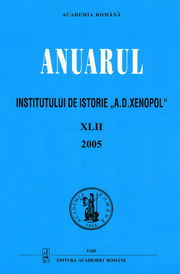ARHEOLINGVISTICA SPAŢIULUI RURAL MEDIEVAL ROMÂNESC
ARCHAEOLINGUISTICS APPROACH OF THE MEDIEVAL RURAL SPACE
IN ROMANIA
Author(s): George-Aurelian BilavschiSubject(s): History
Published by: Editura Academiei Române
Keywords: Romania; Republic of Moldova; Transnistria;armed conflict;
Summary/Abstract: Keywords: archaeolinguistic research, written sources, archaeology, Latin and Slavic language, rural medieval space, medieval agriculture, farming. Studying agriculture in all its manifestations, over historical lapses, requires a different approach and a methodology, based primarily on an interdisciplinary research and invoked by the complexity of the theme, which has its origin, mainly, in the lacunar and ambiguous character of the historical sources. The debates and conclusions from the linguistics, historical and ethnographical fields totalize dozens of books and studies. Closely connected to the achievements made so far, this legacy does not allow the use of the same data for extraordinary results, but only to determine an unbiased evaluation of the historiographical outcomes related to the genesis of rural space and medieval agricultural terminology. However, our initiative proves to be a sustainable functioning apparatus, combining historical, archaeological, philological, linguistic, and ethnographical data and theories on agricultural terminology development, used in the Romanian lands. The significance of concepts disseminated and appropriated in Romanian historiography constitutes significant data to improve current research. From the very beginning we emphasize our support for the ideas and arguments made so far by the majority of the Romanian specialists. However, we propose a methodology based on a comparative approach and the development of a thematic topic combining historical, archaeo-logical, linguistic and ethnographical discoveries. If until now, researchers focused more on surveying the phonetic and semantic features, an important aspect is to discover the morphological and chronological evolution under the impact of external factors (linguistic influences of foreign idioms under the action of the ethno-demo-graphical, social-economic, political and cultural transmogrification). Phonetic and semantic surveys offer a special prominence to relative dating of the foreign words, borrowed from different languages used by populations that have culturally interacted with local communities over centuries. Regarding the agrarian and pastoral terminology research, Romanian and foreign linguists argued for a Latin origin of terms related to agriculture; in the same time, they accepted the enrichment with words coming mainly from the Slavonic languages, but also from German, Greek, Turkish, Hungarian etc. Investigations have revealed a mixture of Latin and Slavic terms. It is challenging to stipulate which of them occurred as an outcome of technical improvements, but it can certainly be argued that a large part of these terms were borrowed from the newcomers lexicon to describe unknown historical and economic realities. Nevertheless, the new concepts gained deep roots in the Romanian agricultural and pastoral language only after a long period (at least three centuries) of coexistence with Slavic communities in the Carpathian-Danubian space. Systematic villages and houses, yards, tilled soil, fields with crops, garden tools, and domestic animals stand as indicators of sedentary and agrarian life continuity into a rural structure, throughout the centuries. Living together with other populations (such as the Slavs), the Romanians took over alien terms that were simultaneously used in the current vocabulary. Thus, for distinct features and matters of Romanian agrarian life have survived one, two, or even more terms. Gradually, one word substituted the others, strongly tied with the technical progress and readjustment of the tools, agricultural techniques and pastoral practices. Likely, in 6th-9th centuries, under the impact of Slavic migration towards Western and Southern Europe, their culture influenced autochthonous way of life and vocabulary. Within the historical context, framed by economic, political and strategic interests of the “Great Powers” (the Byzantine Empire, Hungary, Poland, Golden Horde, Ottoman Empire, Habsburg, Russia), the Romanian language has got linguistic influences from Slavic, German, Turkish, Bulgarian, Serbian and Croatian, Greek, Hungarian, Russian, etc. Political dichotomy was not linked up or followed by ethnic and linguistic disjuncture because the Romanians have continued to exist on both sides of the Carpathian Mountains and beyond conventional boundaries, being unified by language, traditions, culture and confessional affiliation. In these circumstances, the culture and language features of Romanians transcended over the centuries. As we shall notice in this paper, language is not a given unit as an unabridged assembly as it had been back in its early stages of existence, but embodies an entity in a continuous regeneration and enrichment, always improving its vocabulary, morphology, etymology and the structural semantics of the terms. This language rises therefore to a broader historical process, spread out during several centuries. Each accomplished level represents, in its turn, the starting point for new changes and improvements.
Journal: Anuarul Institutului de Istorie »A.D. Xenopol« - Iaşi
- Issue Year: LI/2014
- Issue No: Supl. 1
- Page Range: 35-57
- Page Count: 23
- Language: Romanian

